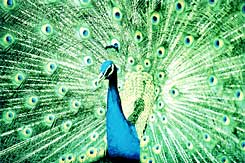As Newton predicted, there is no need for pigments
Carol Keisuk Yoon

A peacock. "It's an ingenious and simple method to diversify colors," the researchers said
Direct link to this page: https://www.hayadan.org.il/eintavas.html
For hundreds of years, people have admired the beauty of the peacock's colors, and the magnificent bird has at different times been a symbol of divine beauty, endless love, heaven, purity and God's wisdom. Now Chinese physicists have deciphered the secret of the peacock's rainbow of colors.
In a study published this month in the journal "National Academy of Sciences" Proceedings of the, researchers report that slight changes in the arrangement of the substances keratin and melanin create the color palette that appears in the eye-like spot in the peacock's tail feather. Keratin is a substance found among other things in human nails; Melanin is the substance that darkens the skin. "This is an ingenious and simple method to diversify colors," said Dr. Jian Zi, a physicist at Pudan University in Shanghai and lead author of the study.
Zee began the research with colleagues after being impressed by the sight of peacock feathers in a Chinese market. "I am an optics researcher," said Zee, "when I observed the feathers against the sunlight, it was a fascinating experience. I thought to myself, what could create such a variety of colors?"
The peacock feather is made up of a rigid central quill, on either side of which are rows of small sections. On both sides of each section there are rows of tiny subsections. When scientists examined the subsections under a high-powered electron microscope, they saw that the subsections were coated with a highly ordered structure of tiny melanin sticks connected by keratin.
But the researchers also found that sections with different colors differ slightly in the arrangement of these matrices. Depending on the number of sticks stacked on top of each other and the spacing between them, the tiny subsection can appear yellow, green, blue, or brown.
Scientists tested the importance of these structures in the formation of the color by dipping the feathers in glycerin. Filling the tiny air holes with a clear liquid changes the structure of the feather. This is how they discovered that the glycerin slightly changed the colors of the feather, and this would not have happened if pigments were the cause of the formation of the color.
Colors in nature are usually created by pigments. When light hits a pigment, the color red, for example, is created because the pigment absorbs all light rays, except the red light. This light is reflected back and absorbed by the eye, which sees the color red. On the other hand, different colors are created in peacock feathers thanks to the precise structure of the melanin sticks contained within keratin. Thus a certain arrangement reflects yellow light, while a slightly different arrangement reflects blue light. These "structural colors," as they are called, are closer to the way colorless water droplets reflect light and create the colors of the rainbow than to the way pigments would create the colors of the rainbow in a painting.
Zee noted that he and his colleagues were not the first to fall under the peacock's spell. According to him, they were just following in the footsteps of Sir Isaac Newton, who hypothesized about 300 years ago that peacock feather colors might be based on structural coloring.
A strange and interesting scholar
https://www.hayadan.org.il/BuildaGate4/general2/data_card.php?Cat=~~~675362783~~~30&SiteName=hayadan
